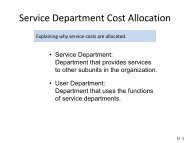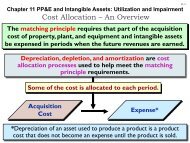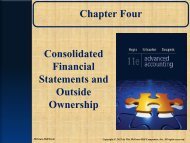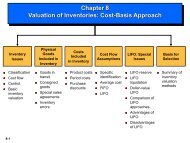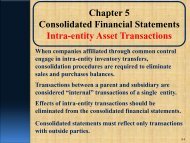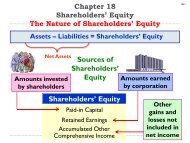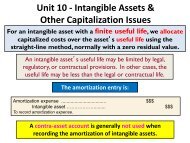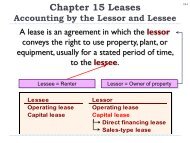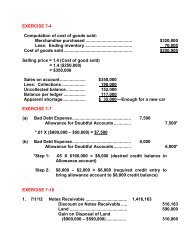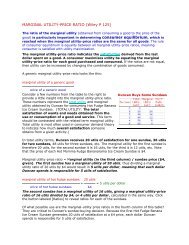Definition of 'Currency Swap' Currency Swap Basics - Anna Lee
Definition of 'Currency Swap' Currency Swap Basics - Anna Lee
Definition of 'Currency Swap' Currency Swap Basics - Anna Lee
Create successful ePaper yourself
Turn your PDF publications into a flip-book with our unique Google optimized e-Paper software.
<strong>Definition</strong> <strong>of</strong> <strong>'<strong>Currency</strong></strong> <strong><strong>Swap</strong>'</strong>http://www.investopedia.com/terms/c/currencyswap.asp#ixzz2KAqmXQ1pA swap that involves the exchange <strong>of</strong> principal and interest in one currency for the same in anothercurrency. It is considered to be a foreign exchange transaction and is not required by law to be shownon a company's balance sheet.For example, suppose a U.S.-based company needs to acquire Swiss francs and a Swiss-based companyneeds to acquire U.S. dollars . These two companies could arrange to swap currencies by establishingan interest rate, an agreed upon amount and a common maturity date for the exchange. <strong>Currency</strong> swapmaturities are negotiable for at least 10 years, making them a very flexible method <strong>of</strong> foreign exchange.<strong>Currency</strong> swaps were originally done to get around exchange controls.<strong>Currency</strong> <strong>Swap</strong> <strong>Basics</strong>May 24 2011| Filed Under » Banking, Business, Currencies, <strong>Currency</strong> Derivatives, Forex, ForexTheory, Forex Trading Strategies, Forex-Intermediate, International Markets, <strong>Swap</strong>s<strong>Currency</strong> swaps are an essential financial instrument utilized by banks, multinational corporations andinstitutional investors. Although these type <strong>of</strong> swaps function in a similar fashion to interest rate swapsand equity swaps, there are some major fundamental qualities that make currency swaps unique andthus slightly more complicated. (Learn how these derivatives work and how companies can benefit fromthem. Check out An Introduction To <strong>Swap</strong>s.)TUTORIAL: Introduction To The Forex MarketA currency swap involves two parties that exchange a notional principal with one another in order togain exposure to a desired currency. Following the initial notional exchange, periodic cash flows areexchanged in the appropriate currency.Let's back up for a minute to fully illustrate the function <strong>of</strong> a currency swap.Purpose <strong>of</strong> <strong>Currency</strong> <strong>Swap</strong>sAn American multinational company (Company A) may wish to expand its operations into Brazil.Simultaneously, a Brazilian company (Company B) is seeking entrance into the U.S. market. Financialproblems that Company A will typically face stem from Brazilian banks' unwillingness to extend loans tointernational corporations. Therefore, in order to take out a loan in Brazil, Company A might be subjectto a high interest rate <strong>of</strong> 10%. Likewise, Company B will not be able to attain a loan with a favorableinterest rate in the U.S. market. The Brazilian Company may only be able to obtain credit at 9%.
While the cost <strong>of</strong> borrowing in the international market is unreasonably high, both <strong>of</strong> these companieshave a competitive advantage for taking out loans from their domestic banks. Company A couldhypothetically take out a loan from an American bank at 4% and Company B can borrow from its localinstitutions at 5%. The reason for this discrepancy in lending rates is due to the partnerships andongoing relations that domestic companies usually have with their local lending authorities. (Thisemerging market is making strides in regulation and disclosure. See Investing In China.)Setting Up the <strong>Currency</strong> <strong>Swap</strong>Based on the companies' competitive advantages <strong>of</strong> borrowing in their domestic markets, Company Awill borrow the funds that Company B needs from an American bank while Company B borrows thefunds that Company A will need through a Brazilian Bank. Both companies have effectively taken out aloan for the other company. The loans are then swapped. Assuming that the exchange rate betweenBrazil (BRL) and the U.S (USD) is 1.60BRL/1.00 USD and that both Companys require the same equivalentamount <strong>of</strong> funding, the Brazilian company receives $100 million from its American counterpart inexchange for 160 million real; these notional amounts are swapped.Company A now holds the funds it required in real while Company B is in possession <strong>of</strong> USD. However,both companies have to pay interest on the loans to their respective domestic banks in the originalborrowed currency. Basically, although Company B swapped BRL for USD, it still must satisfy itsobligation to the Brazilian bank in real. Company A faces a similar situation with its domestic bank. As aresult, both companies will incur interest payments equivalent to the other party's cost <strong>of</strong> borrowing.This last point forms the basis <strong>of</strong> the advantages that a currency swap provides. (Learn which tools youneed to manage the risk that comes with changing rates, check out Managing Interest Rate Risk.)Advantages <strong>of</strong> the <strong>Currency</strong> <strong>Swap</strong>Rather than borrowing real at 10% Company A will have to satisfy the 5% interest rate paymentsincurred by Company B under its agreement with the Brazilian banks. Company A has effectivelymanaged to replace a 10% loan with a 5% loan. Similarly, Company B no longer has to borrow fundsfrom American institutions at 9%, but realizes the 4% borrowing cost incurred by its swap counterparty.
Under this scenario, Company B actually managed to reduce its cost <strong>of</strong> debt by more than half. Instead<strong>of</strong> borrowing from international banks, both companies borrow domestically and lend to one another atthe lower rate. The diagram below depicts the general characteristics <strong>of</strong> the currency swap.Figure 1: Characteristics <strong>of</strong> a <strong>Currency</strong> <strong>Swap</strong>For simplicity, the aforementioned example excludes the role <strong>of</strong> a swap dealer, which serves as theintermediary for the currency swap transaction. With the presence <strong>of</strong> the dealer, the realized interestrate might be increased slightly as a form <strong>of</strong> commission to the intermediary. Typically, the spreads oncurrency swaps are fairly low and, depending on the notional principals and type <strong>of</strong> clients, may be inthe vicinity <strong>of</strong> 10 basis points. Therefore, the actual borrowing rate for Companyies A and B is 5.1% and4.1%, which is still superior to the <strong>of</strong>fered international rates.<strong>Currency</strong> <strong>Swap</strong> <strong>Basics</strong>There are a few basic considerations that differentiate plain vanilla currency swaps from other types <strong>of</strong>swaps. In contrast to plain vanilla interest rate swaps and return based swaps, currency basedinstruments include an immediate and terminal exchange <strong>of</strong> notional principal. In the above example,the US$100 million and 160 million reals are exchanged at initiation <strong>of</strong> the contract. At termination, thenotional principals are returned to the appropriate party. Company A would have to return the notionalprincipal in reals back to Company B, and vice versa. The terminal exchange, however, exposes bothcompanies to foreign exchange risk as the exchange rate will likely not remain stable at original1.60BRL/1.00USD level. (<strong>Currency</strong> moves are unpredictable and can have an adverse effect on portfolioreturns. Find out how to protect yourself. See Hedge Against Exchange Rate Risk With <strong>Currency</strong> ETFs.)Additionally, most swaps involve a net payment. In a total return swap, for example, the return on anindex can be swapped for the return on a particular stock. Every settlement date, the return <strong>of</strong> oneparty is netted against the return <strong>of</strong> the other and only one payment is made. Contrastingly, because theperiodic payments associated with currency swaps are not denominated in the same currency,
payments are not netted. Every settlement period, both parties are obligated to make payments to thecounterparty.Bottom Line<strong>Currency</strong> swaps are over-the-counter derivatives that serve two main purposes. First, as discussed in thisarticle, they can be used to minimize foreign borrowing costs. Second, they could be used as tools tohedge exposure to exchange rate risk. Corporations with international exposure will <strong>of</strong>ten utilize theseinstruments for the former purpose whileinstitutional investors will typically implement currencyswaps as part <strong>of</strong> a comprehensive hedging strategy.



